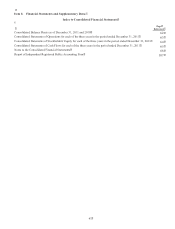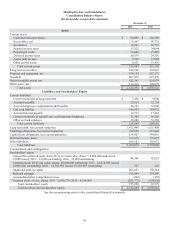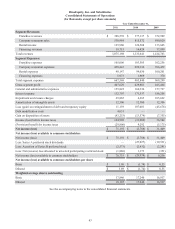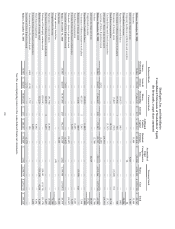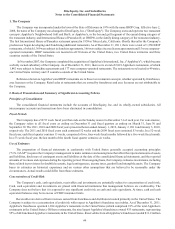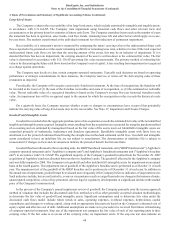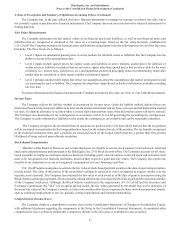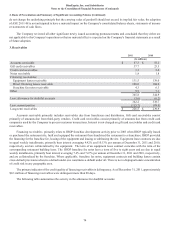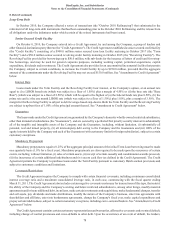IHOP 2011 Annual Report Download - page 89
Download and view the complete annual report
Please find page 89 of the 2011 IHOP annual report below. You can navigate through the pages in the report by either clicking on the pages listed below, or by using the keyword search tool below to find specific information within the annual report.DineEquity, Inc. and Subsidiaries
Notes to the Consolidated Financial Statements (Continued)
2. Basis of Presentation and Summary of Significant Accounting Policies (Continued)
71
The Company has, in the past, utilized derivative financial instruments to manage its exposure to interest rate risks, but is
not currently a party to any derivative financial instruments. The Company does not enter into derivative financial instruments for
trading purposes.
Fair Value Measurements
The Company determines the fair market values of its financial assets and liabilities, as well as non-financial assets and
liabilities that are recognized or disclosed at fair value on a recurring basis, based on the fair value hierarchy established in
U.S. GAAP. The Company measures its financial assets and liabilities using inputs from the following three levels of the fair value
hierarchy. The three levels are as follows:
• Level 1 inputs are unadjusted quoted prices in active markets for identical assets or liabilities that the Company has the
ability to access at the measurement date.
• Level 2 inputs include quoted prices for similar assets and liabilities in active markets, quoted prices for identical or
similar assets or liabilities in markets that are not active, inputs other than quoted prices that are observable for the asset
or liability (i.e., interest rates, yield curves, etc.), and inputs that are derived principally from or corroborated by observable
market data by correlation or other means (market corroborated inputs).
• Level 3 includes unobservable inputs that reflect our assumptions about the assumptions that market participants would
use in pricing the asset or liability. The Company develops these inputs based on the best information available, including
our own data.
For more information on the financial instruments the Company measures at fair value, see Note 11, Fair Value Measurements.
Income Taxes
The Company utilizes the liability method of accounting for income taxes. Under the liability method, deferred taxes are
determined based on the temporary differences between the financial statement and tax bases of assets and liabilities using enacted
tax rates. A valuation allowance is recorded when it is more likely than not that some of the deferred tax assets will not be realized.
The Company also determines its tax contingencies in accordance with U.S. GAAP governing the accounting for contingencies.
The Company records estimated tax liabilities to the extent the contingencies are probable and can be reasonably estimated.
The Company recognizes the tax benefit from an uncertain tax position only if it is more likely than not that the tax position
will be sustained on examination by the taxing authorities, based on the technical merits of the position. The tax benefits recognized
in the financial statements from such a position are measured based on the largest benefit that has a greater than fifty percent
likelihood of being realized upon ultimate resolution.
Stock-Based Compensation
Members of the Board of Directors and certain employees are eligible to receive stock options, restricted stock, restricted
stock units and performance units pursuant to the DineEquity, Inc. 2011 Stock Incentive Plan. The Company accounts for all stock-
based payments to employees and non-employee directors, including grants of stock options, restricted stock and restricted stock
units to be recognized in the financial statements, based on their respective grant date fair values. The Company also reports the
benefits of tax deduction in excess of recognized compensation cost as a financing cash flow.
U.S. GAAP requires companies to estimate the fair value of stock-based payment awards on the date of grant using an option-
pricing model. The value of the portion of the award that is ultimately expected to vest is recognized as expense ratably over the
requisite service periods. The Company has estimated the fair value of each award as of the date of grant or assumption using the
Black-Scholes option pricing model, which considers, among other factors, the expected life of the award and the expected volatility
of the Company' stock price. Although the Black-Scholes model meets the requirements of U.S. GAAP and the Securities and
Exchange Commission (the "SEC") as an option-pricing model, the fair values generated by the model may not be indicative of
the actual fair values of the Company's awards, as it does not consider other factors important to those stock-based payment awards,
such as continued employment or service, periodic vesting requirements and limited transferability.
Comprehensive Income (Loss)
The Company displays comprehensive income (loss) in the Consolidated Statements of Changes in Stockholders' Equity,
with additional disclosure regarding the components in the Notes to the Consolidated Financial Statements. Accumulated other
comprehensive loss is primarily attributable a temporary decline in the fair value of available-for-sale securities.


